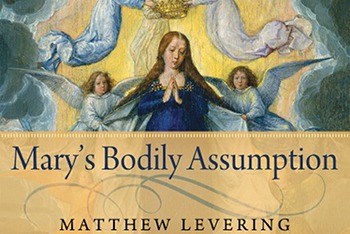Matthew Levering’s newest publication, Mary's Bodily Assumption (Notre Dame: University of Notre Dame Press, 2015) sheds bright light on his passion for and expertise in ecumenical dialogue. Erudite and supplied with extensive notes, this ambitious and thought-provoking work aims at showing how Mary’s bodily Assumption, and by extension all Marian dogmas, is a logical implication of Mary’s mission as Theotokos (2).
When Pius XII defined and proclaimed the dogma of Mary’s bodily Assumption into heaven on November 1, 1950, he could count on the overwhelming support of those in communion with the Apostolic See. It is therefore astonishing that, since then, very little further exploration of the doctrine has occurred. In fact, the last book in English on Mary’s Assumption was published more than thirty years ago,[1] while “during this same time period, however, Protestant (and especially Evangelical) interest in Mary has increased significantly” (2). Filling this lacuna, the distinguished, well-known scholar and Perry Family Professor of Theology at Mundelein Seminary offers a systematic and ecumenical rationale for the newest Marian dogma that also aids Catholics in a proper understanding of Mary’s Assumption. Both aspects—ecumenical dialogue and in-depth Marian teaching—are a rare combination in current academic discourse, wherefore Professor Levering is to be commended for his courage, expertise, as well as humility to take on this challenge.
The monograph is divided in two parts with three chapters each. Part One, a historical exposition, summarizes “the vibrant twentieth-century Catholic discussions” on Mary’s Assumption: the magisterial teaching [ch. 1], the contribution of Neo-Scholasticism [ch. 2], and the work of ressourcement thinkers [ch. 3]. Levering skillfully shows how each of these teachings contains the three pillars on which faith in Mary’s Assumption rests: biblical typology, the authority of the Church, and doctrinal fittingness. Part Two, a constructive investigation, defends these three pillars in dialogue with Cardinal Newman and Protestant scholars. A short description of each chapter follows.
Chapter one, comparing Munificentissmus Deus with Lumen Gentium chapter eight and post-Vatican II magisterial documents, shows that the former, though not devoid of scriptural references, takes its bearing mainly from the privilege of Mary’s Immaculate Conception and sinlessness, while the latter rely chiefly on biblical portrayals of Mary and typology. Both methods shed light on the fittingness of Mary’s Assumption at the end of her earthly journey (17).
Chapter two presents the work of three representatives of Neo-Scholasticism. Joseph Duhr, SJ and Aloïs Janssens show that the Eve-Mary parallel underscores Mary’s inseparable union with Christ and argue that the typological argument of fittingness is a means for the Church to interpret revelation infallibly. Reginald Garrigou-Lagrange, OP focuses on Mary’s faith and predestination as Mother of Jesus Christ, both of which configured her to her Son’s charity and glory. Levering correctly questions Garrigou-Lagrange’s conviction “that there must have been a revelation (implicit or explicit) to the apostles . . . regarding Mary’s assumption” (44–45). He also candidly lays bare the Dominican’s weakness of basing his arguments on historical evidence.
Chapter three introduces the reader to representatives of the nouvelle théologie and their contribution to the dogma of the Assumption. This longest chapter of the book presents us with the assessments of Karl Rahner, SJ, Hans Urs von Balthasar, Louis Bouyer, and Joseph Ratzinger. With his 1951 “Interpretation of the Dogma of the Assumption,” Rahner wished to shed light on the “inner meaning of the dogma.” In view of Jesus’ promise to the good thief (Lk 22:43), Rahner proposes to re-asses the intermediary state (purgatory) as a binding truth of faith, in order to make the dogma intelligible also for other Christians.
Hans Urs von Balthasar argues that the bodily dimension of Mary’s fiat created a union with her Son which, lasting beyond her earthly existence, is indissoluble. Like Rahner, Balthasar believes that “the final judgment and eternal life do not await the end of historical time” (63), a belief applicable foremost to the Blessed Virgin Mary.
Louis Boyer’s position concentrates on Eve’s relationship to Adam; the People of God as Bride of God; and the feminine personification of divine Wisdom. These three Old Testament images serve as a pattern for the New Testament. Mary is second Eve, Mother of the Church, and the Bride of Christ who is still in birth pangs until the marriage with the Lamb is consummated.
Unlike Rahner and von Balthasar, Joseph Ratzinger insists on a waiting period prior to the general resurrection, since otherwise the dogma of the Assumption would be universal. By applying typological exegesis, Ratzinger comes to the double conclusion that Old Testament figures can only be understood in Mary and that New Testament texts cannot provide the sole foundation for Marian doctrine.
Chapter four asks with Cardinal Newman whether typological interpretation of Sacred Scripture reveals deeper levels of signification in the persons and events in salvation history. Levering surveys three Protestant authors and their approach to typological exegesis. While all three—Richard B. Hays, Peter Enns, and Peter Leithart—recognize the importance of exegetical typology, none of them applies it to Mary’s Assumption.
In chapter five, contrasting Cardinal Newman’s position with that of Jaroslav Pelikan, Levering investigates the notion of authority in Scripture, since the Assumption cannot be treated solely typologically. Just as Scripture does not contain a formulated doctrine of the Trinity, the belief of Mary’s Assumption is likewise a fruit of a long development. Levering agrees with Ratzinger that Christ’s saving act cannot be fully understood if we exclude Mary, pre-redeemed and fully redeemed.
Chapter six underscores the fittingness of Mary’s Assumption in the economy of salvation as delineated by Cardinal Newman. Levering offers three analogies to support the fittingness of Mary’s bodily assumption into heaven. As the New Eve, Mary is the Ark of the New Covenant which is incorruptible. Mary’s Magnificat echoes her election as Daughter Zion, the faithful bride of Christ glorified in heaven. Mary’s Assumption exemplifies the effect of Christ’s Incarnation and Redemption.
In his concluding remarks Levering states his hope that Christians of Protestant, Catholic, and Orthodox traditions will benefit from this study on how belief in Mary’s Assumption can be supported in today’s world. Levering’s unbiased approach and his admittance of misinterpretations from Catholics render this book appealing and an asset to ecumenical dialogue. Besides its engaging dialogue with Protestant, Orthodox, and Catholic theologians concerning the doctrine of Mary’s Assumption, Levering’s presentation of the organic development of Marian doctrine makes this study an indispensable resource, not only but especially, for Marian scholars. Although Levering chooses to concentrate on the immediate twentieth-century theological influences on the definition of the dogma, he nevertheless ably draws into the discussion the voices of the Church Fathers and theologians of the past two millennia. This reviewer, however, misses the inclusion of the dissertation by Paul E. Duggan,[2] of the Ecumenical Society of the Blessed Virgin Mary, the Mariological Society of America, as well as the Dombes Group,[3] who have all greatly contributed to the study of Mary’s Assumption.
The timeliness of Levering’s book, whether intended or not, may be seen as a providential and pedagogical opportunity to shed light on the Christian concept of the fully redeemed person and our own pilgrimage of faith, since Mary’s Assumption is not only unique but representative as well. The author’s hope is that the doctrine of Mary’s Assumption will further illumine our Christian understanding of the eschaton. Like the Immaculate Conception, Mary’s Assumption into heaven is a latreutic dogma, confirming the great deeds of God in the life of the Blessed Virgin Mary. Its implication for our time marked by a culture of death and frequent indifference to the dignity of human life, however, may not be overlooked. In this light, Mary’s privileges at the beginning and end of her earthly pilgrimage present us with a compendium of faith concerning the God-willed image of the human person, as a response to the anthropological heresies prevalent in our time. Although beyond the scope of Levering’s work, this discussion may still draw from this greatly researched, non-polemical, and highly recommended resource.
![]()
[1] Kilian Healy, The Assumption of Mary (Wilmington, Del.: Michael Glazier, Inc., 1982, reprinted by Carmelite Media in 2011). Healy regretted not to have included a chapter on ecumenical dialogue which “would have been helpful to those who sincerely study it yet differ.”
[2] The Assumption Dogma: Some Reactions and Ecumenical Implications in the Thought of English-Speaking Theologians (Dayton, OH: International Marian Research Institute, 1989).
[3] Alain Blancy, Maurice Jourjon, Groupe des Dombes, Mary in the Plan of God and in the Communion of the Saints: toward a Common Christian Understanding (New York: Paulist Press, 2002).



